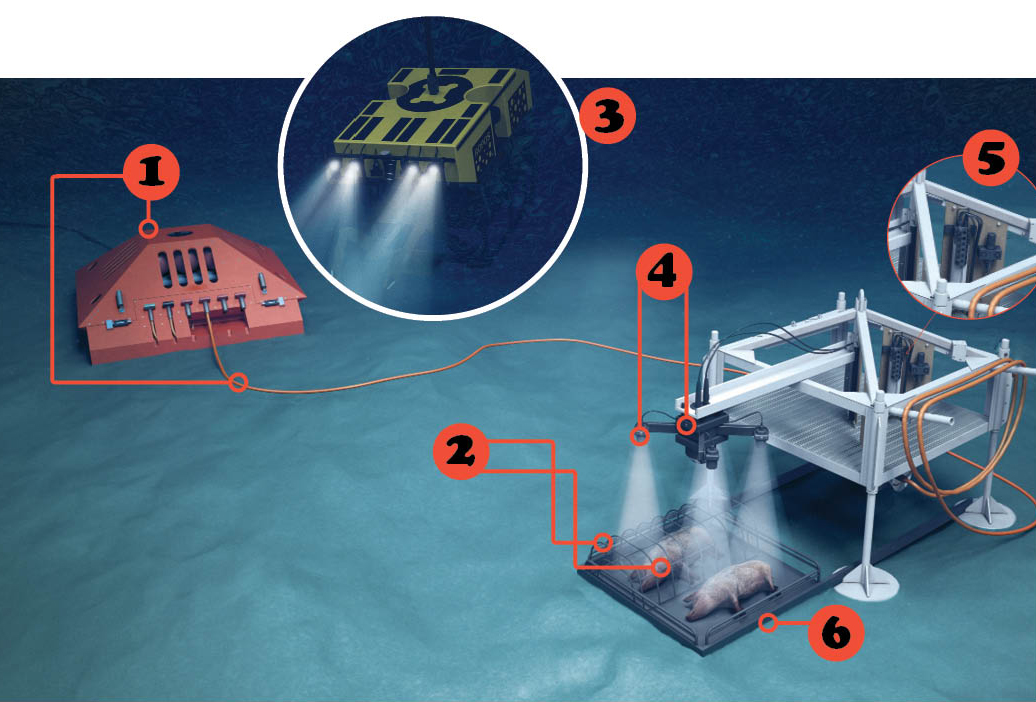

A dead pig is a good proxy for a dead person: It’s roughly the size of a human torso, it has no fur, and its gut holds similar bacteria. These parallels mean that injury and decay are comparable in the two species, which can help forensic pathologists learn more about how corpses behave. On land, this dark research is easy—place the pig somewhere, and watch it rot. But what about bodies at sea? When a corpse turns up in a marine environment, whether as a result of murder, accident, or tsunami, coroners and pathologists don’t have the information they need to determine even the time of death.
In 2000, forensics researcher Gail Anderson, of Simon Fraser University in British Columbia, was the first to simulate a marine grave; she sent divers to place pig carcasses underwater and chronicled the decay that followed, as crabs, shrimp, and sea lice devoured them. Then, in 2006, Anderson began conducting research with Venus, a cabled ocean observatory that broadcasts underwater views of offshore British Columbia live over the Internet. The researchers used a remotely operated vehicle to plunk a pig in view of a camera, which recorded the action as sea life destroyed it. Twenty-two pigs later—and with more scheduled for this fall—Anderson’s team is learning how to tell whether a body decayed on a sandy or rocky surface, whether it came from fresh- or saltwater, and whether its wounds are from a knife or a crab.
The work is already paying off. After several human feet clad in athletic shoes started washing up on Vancouver’s shores in 2007, Anderson quashed speculation that a serial killer was lopping them off. The cause of death still isn’t clear, but we now know that sea life snipped away enough tissue that the feet fell off on their own.
1. Information Superhighway
A two-ton node—basically a large waterproof Ethernet hub—connects the experimental setup to a 1.5-inch cable, which provides power and transmits video, photos, and data over the Internet for scientists and the public to check out.
2. Hog-Tied
Two pigs are tethered to an instrument platform to keep sea critters from dragging them out of camera range. One sits in the most natural setting possible, while a backup is encased in a cage—a feature added after an experiment was largely ruined by hungry six-gilled sharks.
3. Briny Bot
The deep-sea vehicle Ropos (remotely operated platform for ocean sciences) delivers the pigs and their instrument platform to a node and plugs in a webcam and sensors with dexterous arms. When the experiment ends, Ropos swims back, unplugs everything, and brings the remains and the platform back to its mothership.
4. Lights, Camera, Action
The experiments run hundreds of feet underwater, where it is pitch black. In order to capture the pigs’ decomposition on video, four lights flash on for a few minutes every quarter hour (constant light would scare away too many animals, changing how the pigs decay). The high-definition camera can be panned or tilted remotely.
5. Devices, Dunked
A set of sensors measures the water’s temperature, salinity, and oxygen concentration, all of which could impact how the pigs decompose.
6. Bacon On The Side
The platform’s bottom is plastic mesh, which lets silt microbes eat away at the pigs while collecting the bones for later study (by Lynne Bell, a forensics anthropologist at Simon Fraser University).
Sea lice mob devours pig from the inside out Sandrine Ceurstemont, editor New Scientist TV
This article originally appeared in the July 2013 issue of Popular Science. See the rest of the magazine here.
